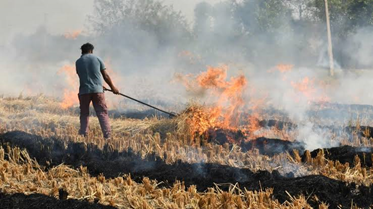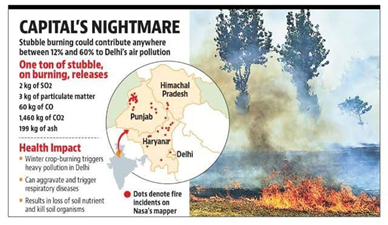Stubble Burning in India
Relevance
- GS Paper 3 Conservation, Environmental Pollution and Degradation, Environmental Impact Assessment.
- Tags: #GS3 #UPSC #EnvironmentalPollution #StubbleBurning #AirPollution #AirPollution #Parali.
Why in the news?
Stubble burning, primarily in the states of Punjab and Haryana, has emerged as a significant environmental concern in India. This practice, prevalent after the rice and wheat harvests, contributes to air pollution, and soil degradation, and impacts human health. The issue has gained notoriety due to its role in exacerbating the air quality crisis in the northern regions, especially during the winter months.
What is Stubble?
Stubble(Parali) refers to the short, remaining crop stalks and plant material left in fields after the primary crop, like rice or wheat, has been harvested. This residue is typically removed or managed to prepare the field for the next crop cycle.
What is Stubble Burnings?
Stubble burning is the practice of deliberately setting fire to crop residues, such as straw and stubble, after a harvest. This method is used to clear fields quickly for the next planting but contributes to air pollution and environmental issues.
The Causes of Stubble Burning
Agronomic Factors
The primary driver of stubble burning is the tight crop rotation cycle in Punjab and Haryana. Farmers cultivate rice during the Kharif season, which is immediately followed by the wheat crop in the Rabi season. The narrow window between these two crops leaves little time for crop residue management.
Labor-Intensive Agriculture
Labor shortages for farm activities like manual harvesting and stubble removal have encouraged the use of mechanized combine harvesters that leave behind crop residue. Removing this residue is time-consuming, expensive, and logistically challenging.
Economic Pressures
Increasing input costs, declining water tables, and stagnant crop prices have led farmers to seek ways to reduce expenses. Stubble burning offers a quick and low-cost method to prepare fields for the next crop cycle.
Consequences of Stubble Burning
Air Pollution
Stubble burning releases harmful pollutants, including PM2.5 , carbon monoxide, volatile organic compounds,Sulphur Oxides and nitrogen oxides, etc into the atmosphere. These pollutants contribute to poor air quality, particularly during the winter months.
Health Impact
Poor air quality resulting from stubble burning leads to respiratory diseases, allergies, and eye irritation. Vulnerable populations, including children and the elderly, are at higher risk of health problems.
Soil Degradation
Stubble burning causes the loss of valuable organic matter and nutrients in the soil. The practice affects soil fertility and long-term agricultural sustainability.
Economic Losses
Beyond environmental and health issues, the economic losses associated with poor air quality are substantial. Decreased worker productivity, increased healthcare costs, and damage to ecosystems impact the overall economy.
NCR and Stubble Burning
Experts say stubble burning accounts for anywhere between 12% and 60% of Delhi’s air pollution.
- Stubble burning during October 2022 added 5-8% to Delhi’s overall PM2. 5 pollution.
- Farm fires contributed 25% to the PM2. 5 pollution in Delhi on Diwali in 2021, 32% in 2020, and 19% in 2019.
Government Policies and Initiatives
- National Policy for Management of Crop Residue: The government has launched a comprehensive policy to address stubble burning. The plan includes measures like financial assistance for purchase of farm equipment, promoting crop diversification, and establishing Custom Hiring Centers (CHCs) to provide machinery for residue management.
- Happy Seeder Program: The government has promoted the use of Tubro Happy Seeders, which are machines that can plant wheat seeds without the need for clearing fields of rice straw. This initiative encourages sustainable agriculture practices.
- Financial Incentives: Various state governments offer financial incentives and subsidies to farmers for adopting residue management machinery, like straw balers and straw management systems.
- Remote Sensing Technology: The government uses remote sensing technology to monitor stubble burning activities. This helps in identifying violators and enforcing penalties.
- Awareness Campaigns: Initiatives like “Parali Pratisad” (stubble management campaign) have been launched to raise awareness among farmers about the importance of residue management.
Other Techniques of mitigation
In Situ
- Mulching: Mulching is the practice of leaving crop residue on the soil surface to protect the soil from erosion and retain moisture.
- No-till farming: No-till farming involves planting crops without disturbing the soil. This method helps to conserve soil moisture and reduce soil erosion.
- Bio Decomposers like Pusa Bio-decomposers decompose crop residue.
Example- Haryana state government is providing Pusa decomposers kits free of cost to farmers to manage 5 lakh acre paddy ares.
Ex-Situ
- Biomass power generation: Crop residues can be used as a source of fuel for biomass power generation.
- Biochar production: Biochar is a type of charcoal that is produced by heating crop residues in the absence of oxygen. Biochar can be used as a soil amendment to improve soil fertility, water retention, and crop productivity.
- Industrial uses: Crop residues can be used in various industrial processes, such as the production of paper, textiles, and building materials.
- Composting: This method involves collecting the crop residues and mixing them with other organic materials such as manure, leaves, and grass clippings. The compost can then be used to improve soil fertility and structure.
Challenges and Roadblocks
- Limited Awareness: Farmers often lack awareness about the harmful impacts of stubble burning, the available alternatives, and government initiatives.
- Economic Considerations: Farmers need incentives and assistance to transition to alternative practices like Happy Seeders or straw management systems, which require an initial investment.
- Technological Barriers: The availability and affordability of residue management machinery are concerns in some areas. Making this technology accessible to all farmers is a challenge.
- Short Timeframe: The small window between rice and wheat cultivation leaves farmers with little time for residue management. Mechanization can help, but it is not widely adopted.
- Enforcement and Regulation: Ensuring strict enforcement of anti-stubble burning regulations and penalties remains a challenge.
Potential Solutions
- Technology Adoption: Encouraging farmers to adopt machinery for crop residue management is vital. This includes making technology affordable through subsidies and easy financing options.
- Crop Diversification: Promoting diversification of crops beyond rice and wheat can provide farmers with longer intervals between crop cycles, allowing for more effective residue management.
- Government Support: Governments must offer comprehensive assistance, including financial incentives, to make alternative practices like the Happy Seeder more accessible.
- Education and Awareness: Extensive awareness campaigns about the adverse effects of stubble burning, as well as alternative practices, are essential.
- Community Participation: Involving local communities, NGOs, and agricultural extension workers in promoting residue management practices can make a significant difference.
- Innovative Solutions: Research and development into innovative residue management solutions can help create more accessible and affordable technologies for farmers.
Stubble burning is a complex issue deeply rooted in agricultural practices, economic pressures, and a lack of awareness. It is vital to approach this issue holistically by addressing agronomic, economic, and technological aspects. Government initiatives, financial incentives, and community involvement are crucial in transitioning to sustainable agricultural practices. The ultimate goal is to reduce air pollution, protect human health, and ensure the long-term environmental and agricultural sustainability of the region.
Source: Sansad TV, PIB, MOEFCC.
Mains Question
Stubble burning in northern states of India is a significant environmental challenge. Discuss the causes and government initiatives to mitigate this issue, highlighting the need for holistic solutions to address the problem.





